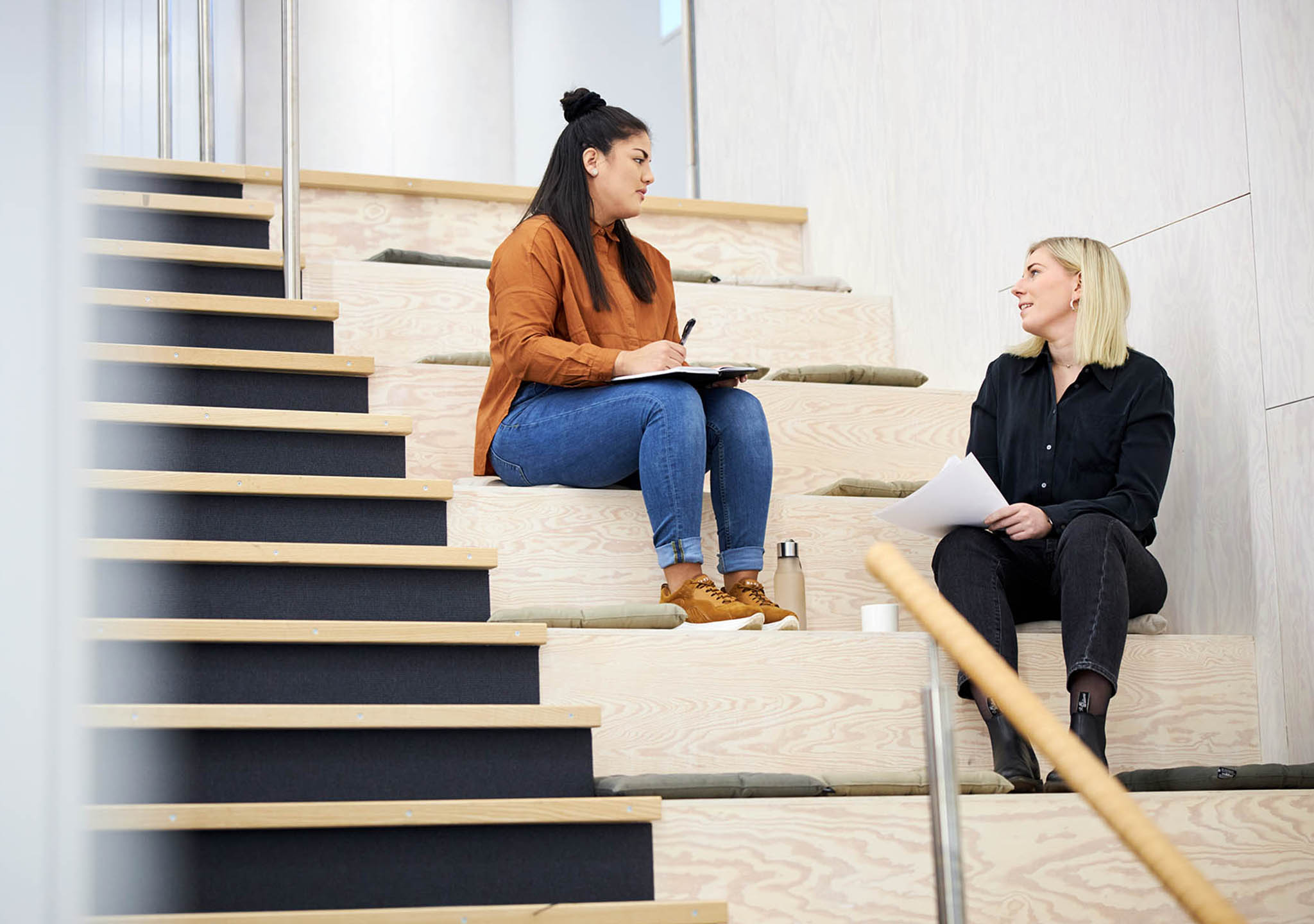
What is the purpose of the office?
To have or not to have, a physical office space – might be the question many companies ask themselves these days. Our flexible and digital way of working during the past year has changed the way we perceive what can pass as a work space. But, post-pandemic, what is really the purpose of a physical office space?
One thing many of us might have lacked this past isolated year, is the culture of a workplace. Even though many of our digital solutions helps us get the job done, it is hard to recreate the dynamics of teamwork and togetherness via the screen. In many positions it has also been difficult to be creative, while sharing a blank document in Teams. That is where the natural waterhole, the office space, is needed and terribly missed.
ENABLES CREATIVE COLLABORATIONS
Workspaces do not need to have unconventional design in order to spark creativity. Foosball tables and slides may look cool, but it is not vital for team creativity or productivity. A creative workplace increases the ability for collaboration, and promotes innovation. But it is really the people behind it that does the magic.
Warren Bennis, late professor at the University of Southern California, describes in his book “Organizing genius: The secrets of creative collaboration ” six creative, innovative incidents in the U.S. during the 20th century. They all took place in very different physical environments; an abandoned warehouse (Walt Disney), an underground bunker (the Manhattan project) and a garage (Hewlett and Packard). The common denominator was the team and the ability to work creatively together.
Another guru in the world of organizational creativity, is Teresa Amabile’s , professor and director of research at Harvard Business School. She states in an interview :
“My research has found that people often do come up with creative ideas and solve complex problems collaboratively by working with other people, and by having their ideas sparked by other people. That is more likely to happen when people are in environments where they run into each other fairly frequently during the workday and in circumstances where they can stand or sit and talk to each other.”
PHYSICAL PAIN AND POSTURE
Another important aspect, that might not have been top of mind for many of us pre-pandemic, is the ergonomics of the workspace. But after spending almost a year at the kitchen table on a wooden chair, our bodies truly feel the difference. In Sweden, sick leave due to physical and mental ailments has increased sharply throughout the beginning of autumn 2020 (according to corporate health company Previa). A serious development for the work environment that does not seem to stop.
The importance of the right ergonomics in the workplace is something interior design and furniture manufacturing company Kinnarps has known for a long time. For nearly 80 years they have created sustainable interior design solutions bearing ergonomics in mind.
– We think it is important to talk about the whole when it comes to ergonomics, both physically and pschycologically says Henrik Axell, Workplace strategist at Kinnarps. There are many different parts that affect how people feel and perform in the office and it’s important to look at the complete experience of a space. A big challenge is to build in movement, since many of us who work in the office sit for many hours every day - which has a clear negative effect on our health. Another important aspect is acoustics. In an office, there should be room for both pulse and silent focus. Both are needed to create an environment that invites collaboration, creativity and innovation as well as concentration, focus and efficiency.
By creating different zones and places for different activities that are needed in the specific office, you can create a dynamic workplace where people can choose environments according to what they are going to do. A well thought out and planned interior design solution which is designed according to mapped needs and work patterns creates the best prerequisites for the employees to feel well, thrive and perform their work in an optimal way.
 "By creating different zones and places for different activities that are needed in the specific office, you can create a dynamic workplace where people can choose environments according to what they are going to do." Henrik Axell, Workplace strategist, Kinnarps
"By creating different zones and places for different activities that are needed in the specific office, you can create a dynamic workplace where people can choose environments according to what they are going to do." Henrik Axell, Workplace strategist, Kinnarps
And when you have the right interior design, you also need the right light. But what is the “right” light?
– The "right light" is utterly individual, says Maja Salinder, Customer Experience Developer at Fagerhults Belysning. For me, ergonomic light is about being able to decide over my own light. It must of course be glare-free and comfortable, but above all, I want to be able to decide over my own light for my workspace. Being able to adjust the direction of the light, its colour temperature and the light level is real light ergonomics for me. This flexibiliyty of light, combined with the ergonomics that Henrik describes, is what I would call a truly ergonomic workplace.
 "Above all, lighting ergonomics for me is to be able to adjust and control the light as I choose. That's what it is there for - to meet my needs." Maja Salinder, Customer Experience Developer Fagerhult
"Above all, lighting ergonomics for me is to be able to adjust and control the light as I choose. That's what it is there for - to meet my needs." Maja Salinder, Customer Experience Developer Fagerhult
FREE TIME, IS ME TIME
One important aspect of going to the office is also - coming home from the office. Having a clear distinction between work and free time is important, psychologically, to be able to recuperate and process. Studies suggests that the real secret to increased efficiency at work might actually lie in resting more . Mental breaks increase productivity, replenish attention, solidify memories and encourage creativity. And to be able to rest from work, it is a clear benefit if you do not have your “work desk” next to your plate of tacos in the kitchen.
Our brain is just like any other muscle in the body, and as such it needs rest to recover. When we rest, we have the time to reflect and review, giving you the opportunity to see work habits or structures that aren’t beneficial for you. A rest day is also a good time to celebrate your accomplishments and refresh your sense of purpose so that you return to work with renewed motivation to get things done.
So, in short, the workspace does not need to look like Googles headquarters (even if it seems like a pretty fun place to do your hours), as long as you have the possibility to randomly bump in to your co-workers by the coffee machine. And do not forget to switch the cell phone off on weekends, and let your brain reboot.
TEXT MARIA VÅRENIUS
PHOTO PATRIK SVEDBERG, LISELOTTE VAN DER MEIJS
Related News

Melanopic lux: lighting for education influenced by human biology
Light is essential in our daily lives, influencing our ability to see, overall well-being and performance. In educational environments, lighting quality can significantly impact students' focus, mood, and energy levels. So, how do we know what is the right amount and quality of light for this setting? Traditionally, light has been measured in lux, a unit of measurement for the intensity of light. It's used to measure how much light falls on a surface or the amount of light in a given space. One lux is the amount of light that falls on a surface that is one square meter in area when one lumen of light is spread out evenly. Recent advancements in research have unveiled the importance of melanopic lux, which goes beyond mere visibility. This measures how effectively light stimulates specific eye cells that regulate crucial non-visual functions such as sleep and alertness. In classrooms and lecture theatres, the melanopic ratio has become vital in lighting design, enabling educators to create spaces that support visual tasks and align with students' biological rhythms. In this article, we explore how lighting solutions can align with our biology, and how this helps to create optimum conditions for educational environments. The science of vision and light The human eye is a remarkable organ designed for high-resolution colour vision within a small area (approximately 2 degrees of the visual field) while relying on peripheral vision for motion detection. This dual-function system, shaped by evolution for survival, continues to influence how we perceive and interact with our surroundings. Our eyes are particularly susceptible to green and yellow light, reflecting our evolutionary adaptation to naturally lit environments. In contrast, blue light, which is chief in modern LED lighting, requires higher intensity to be perceived at the same level. Effective lighting design carefully considers brightness, timing, and distribution to support visual clarity and biological functions like mood and alertness. For example, exposure to bright light in the morning helps regulate circadian rhythms, boosting alertness and mitigating the effects of seasonal darkness. This is particularly important in educational environments, such as schools and universities, where lighting impacts mood, focus, and overall performance. Our Organic Response system provides an innovative solution tailored for these spaces. This smart lighting technology automatically optimises light levels, featuring daylight-responsive sensors and advanced occupancy detection, maintaining a balance between natural and artificial light. Doing so supports visual comfort and reduces energy consumption, making it an ideal choice for creating dynamic, efficient, and student-friendly learning environments. To further support students, well-lit spaces with minimal glare are essential for reducing eye strain and maintaining focus during extended study sessions. Adjusting light intensity and colour temperature for different tasks—such as reading, group discussions, or creative activities—enhances light's visual and non-visual effects. By integrating thoughtful lighting strategies like those offered by Organic Response, educational environments can promote healthier, more productive, and engaging learning experiences. Integrative lighting: Supporting health and well-being. Integrative lighting (also referred to as human-centred lighting) combines visual and non-visual benefits (such as emotional effects) to support biological rhythms and psychological well-being. This approach goes beyond traditional lighting solutions by considering how light impacts circadian rhythms and hormonal balance. Light exposure in the morning is critical for suppressing melatonin (the sleep hormone) and increasing cortisol (the alertness hormone). Proper timing helps align students' natural rhythms with school schedules, which often require a lot of focus. Consistent exposure to bright, cool light early in the day can enhance energy levels and cognitive performance. The melanopic ratio compares the spectral composition of a light source with daylight. Using this information, you can determine its melanopic lighting intensity. This enables the design of lighting setups that precisely meet both visual and biological lighting needs. Lighting recommendations for educational spaces Each learning environment has unique lighting needs. Libraries benefit from direct lighting on the floor, paired with ambient lighting on walls and ceilings. Vertical shelf lighting (200-300 lx) makes it easier to browse titles. Lecture halls, on the other hand, require glare-free, comfortable lighting with flexible control, ideally with pre-programmed scenarios. In auditoriums and classrooms, strong vertical lighting is crucial for clear visual communication, especially over greater distances, enhancing facial expressions and engagement. General lighting recommendations apply to all educational spaces. Our solutions meet industry standards, ensuring reading and writing areas maintain 500 lx for effective visual tasks. Using daylight-responsive sensors for luminaire rows can reduce energy consumption while maximising natural light. The number and arrangement of luminaires should be adjusted based on the room's size and function to ensure consistent illumination. The role of dynamic lighting A Double Dynamic lighting system can be a game-changer in educational environments. It allows for intensity and colour temperature adjustments to match the specific needs of activities, from quiet reading sessions to collaborative group work. Fagerhult's distinct approach to lighting means that our design is human-centric; we integrate scientific insight into light and human psychology, creating environments that support academic performance and well-being. Our focus on energy efficiency also means our advanced control systems optimise light usage while minimising energy consumption, contributing to a building’s sustainability goals. The customisable setting and flexible solutions ensure that educational environments can create tailored lighting profiles for different times of the day or specific learning activities. Long-term benefits of melanopic lighting Melanopic lighting, designed to mimic the natural light spectrum, helps regulate the circadian rhythm, which is essential for maintaining focus, energy, and emotional balance. In classrooms and study areas, proper lighting can reduce eye strain, improve sleep patterns, and enhance mood, which are critical for students' mental health and academic performance. By incorporating lighting that aligns with our biological needs, schools and universities can foster healthier, more productive learning environments,. This is particularly important during the winter months when daylight is limited. Whether through advanced tuneable white light systems, designs that maximise daylight, or energy-efficient solutions, we are dedicated to leading the way in lighting innovation for educational environments, delivering brighter futures—one classroom at a time.
The inspiration behind Nobel Week Lights: ”Light, art and technology intertwined.”
Nobel Week Lights has quickly become a beloved public celebration. During Nobel Week, Stockholm residents flock outdoors to marvel at the spectacular light installations, where contemporary lighting technology meets artistic expression. ”We aim to create a moment of gathering: around light and around something meaningful”, says Lara Szabo Greisman. Nobel Week Lights is a light festival that illuminates Stockholm during the darkest time of the year – a free cultural experience for everyone. Presented by the Nobel Prize Museum, the festival invites international and local artists, designers and students to create light artworks inspired by the Nobel Prize. The installations shed new light on the scientific discoveries, literature and peace efforts of Nobel laureates while offering a fresh perspective on the city. Fagerhult is Principal Partner of Nobel Week Lights 2024, and this year’s edition features 16 different light installations across Stockholm. The artworks can be experienced from 7–15 December, including ”The Wave”, a light installation by the art collective Vertigo, located in front of the Parliament House where visitors can walk right through the luminous wave. The Wave by Vertigo ”Light and art and creativity is incredibly intertwined because these are technologies that are constantly evolving. So part of the fun working with the artists is that they are constantly testing new technologies. And we see these incredible visual results which are based on just pure innovation”, says Lara Szabo Greisman, co-founder and producer of Nobel Week Lights. Lara Lara Szabo Greisman and Leading Lights by Les Ateliers BK The significance of light as a collective force, its ability to encapsulate life and death, joy and sorrow – indeed, the very essence of what it means to be human – makes lighting a powerful medium of artistic expression, she argues: ”The dream for the festival is that this becomes a personal experience for each and every member of the audience. A moment that they remember and cherish . A moment that they think about later and bring forward as their story of connecting with the city.”

